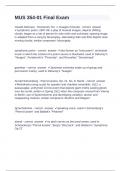Exam (elaborations)
MUS 354 Question and answers 100% correct
- Course
- Institution
MUS 354 Question and answers 100% correct MUS 354-01 Final Exam Claude Debussy - Nocturnes: No. 1, Nuages (Clouds) - correct answer symphonic poem; 1897-99; a play of musical images, depicts shifting clouds, began as a set of pieces for solo violin and orchestra; opening image is adapted from...
[Show more]



